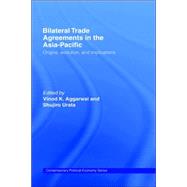
Note: Supplemental materials are not guaranteed with Rental or Used book purchases.
Purchase Benefits
What is included with this book?
| Figures | p. vii |
| Tables | p. viii |
| Contributors | p. xi |
| Preface | p. xii |
| Abbreviations | p. xv |
| Theoretical framework and economic overview | p. 1 |
| Bilateral trade agreements in the Asia-Pacific | p. 3 |
| The political economy of the new Asia-Pacific bilateralism: benign, banal, or simply bad? | p. 27 |
| Bilateralism in the Asia-Pacific: an economic overview | p. 50 |
| Case studies | p. 73 |
| Japan: a new move toward bilateral trade agreements | p. 75 |
| US trade arrangements in the Asia-Pacific | p. 95 |
| Chinese trade bilateralism: politics still in command | p. 117 |
| From multilateralism to bilateralism? a shift in South Korea's trade strategy | p. 140 |
| Who rules the international economy? Taiwan's daunting attempts at bilateralism | p. 160 |
| Singapore trade bilateralism: a two track strategy | p. 184 |
| Why countries are so eager to establish bilateral free trade agreements: a case study of Thailand | p. 206 |
| The reluctant bilateralist: Malaysia's new trade strategy | p. 232 |
| Free trade beyond NAFTA: the economic and institutional rationale for Mexico's bilateral trade agenda | p. 253 |
| Conclusion | p. 277 |
| The evolution and implications of bilateral trade agreements in the Asia-Pacific | p. 279 |
| Index | p. 300 |
| Table of Contents provided by Ingram. All Rights Reserved. |
The New copy of this book will include any supplemental materials advertised. Please check the title of the book to determine if it should include any access cards, study guides, lab manuals, CDs, etc.
The Used, Rental and eBook copies of this book are not guaranteed to include any supplemental materials. Typically, only the book itself is included. This is true even if the title states it includes any access cards, study guides, lab manuals, CDs, etc.